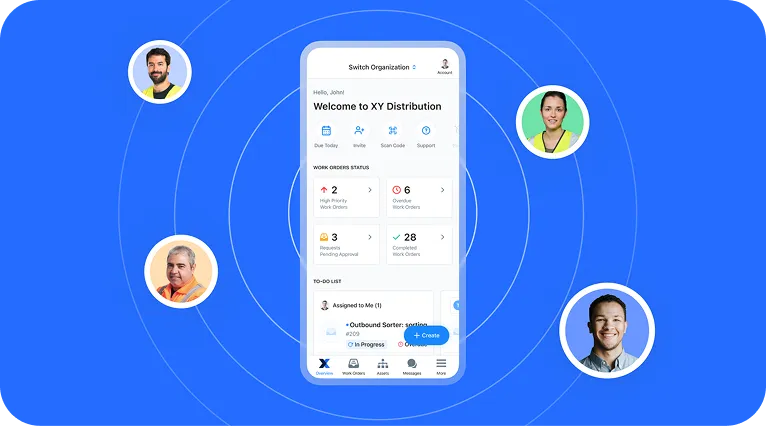.webp)
Maintenance reporting is essential. It helps you set and improve KPIs, move from reactive to preventive maintenance, improve maintenance culture, and track asset health over time. It’s also tough to do without the right tools. There are many CMMS (computerized maintenance management system) options out there, and while each of them has its own reporting features, not all are created equal.
A great maintenance reporting software should provide all the reporting capabilities and flexibility that a maintenance manager needs to do their job well and manage others. It should offer customization, KPI dashboards, and easy and intuitive data collection.
In this guide, we wanted to hear from maintenance teams that are actually using their maintenance management software for their reporting capabilities. We dug through reviews from G2 and Capterra to find the most helpful insights and land on the best solution for maintenance managers.
Key takeaways
- This guide compares six leading maintenance reporting software solutions using 100% user-generated feedback from maintenance management and asset management professionals.
- MaintainX ranks as the top maintenance management system for reporting, praised for its flexible customization, KPI dashboard, and ease of data collection and integration.
Who is this guide for?
This guide is designed for the people who need to pull and present maintenance reports regularly: maintenance leaders, including managers, directors, supervisors, and leads.
How we assessed maintenance reporting solutions for this guide
We assessed each maintenance management software based on direct customer insights from:
- Capterra
- G2
Each solution needed to have a minimum volume of reviews on each platform to ensure well-rounded feedback from users.
The best maintenance management software for reporting: MaintainX
What makes MaintainX the best overall maintenance reporting software:
- Customization: Decision makers can easily create custom views and reports to compare performance across sites, build custom dashboards, and filter insights by team.
- Insights: The KPI dashboard helps anyone easily understand what’s going on and make data-driven decisions to improve metrics.
- Data collection: reporting and forecasting are much easier when data can be easily captured by workers and machines across the organization.
- Automation: Admins can schedule automated reports and export them easily to share across the organization.
What customers like
- Reviewers were happy with how easy MaintainX is to learn and navigate.
- Many noted that the dashboard and reporting features quickly helped them make better, data-driven decisions on how to schedule preventive maintenance.
- Reviewers also noted that, especially for management, there are many advanced features that help make better decisions on asset management for the organization.
What to watch out for
- Some reviewers noted that MaintainX’s advanced reporting took them a little while to figure out.
What customers think of MaintainX’s reporting capabilities:
“I love the dashboard section where you can see an overview of everything.” - AHL H., Handyman Division Manager
“...Collects and aggregates data to provide a window into the future of our equipment that allows us to more accurately predict when failures are more likely to occur and when replacing equipment might make more financial sense than continually repairing.” - Wesley C., PM Coordinator
“MaintainX is a powerful and flexible CMMS that has a vast array of features that a skilled maintenance planner or manager can exercise to drive asset health and organizational growth through data driven decisions.” - Robert B., Staff Equipment Maintenance Engineer
“Reporting - just about everything you could think of including MTTR numbers.” - Frank H., Maintenance Manager
“I love the KPI feature and the ability to customize the application according to what my facility needs!” - Ashley E., Maintenance Manager
“The ability to back track and have historical downtime data has allowed us to provide well organized data and visuals for capital expenditure approvals. Overall, the experience has been wonderful.” - Cody P., Plant Superintendent
“There’s a learning curve with some of the more advanced reporting and dashboard features.” - Todd E., Maintenance Director
How the top maintenance reporting software compare: Key features and feedback
Limble
Key features
- Easy to use: Reviewers like that there was a relatively short and shallow learning curve for both technicians and managers.
- Good basic reporting capabilities: Reviewers noted that reporting was sufficient for high-level insights.
What to watch out for
- Limited features: Several reviewers noted that Limble’s advanced reporting capabilities are lacking.
- Lack of customization: A few reviewers noted frustration with the lack of customization, especially with the dashboard.
“Some of the customization doesn’t do exactly what I want, and I have to get a little creative sometimes to pull the data that I need.” Robert T. (G2)
“The main feature I would like is the ability to add custom categories for better organization and reporting.” - PJ G., Maintenance Manager (G2)
“Would like to see more reporting. A usage report and inventory movement report would be extremely helpful.” Kyle N., Maintenance Coordinator
“For the custom dashboard, you cannot change the time range for all the widgets all at once… However, we want to see the same data with different time ranges (daily, weekly, monthly, quarterly, and annually), so we have to create five duplicate reports or change the time range on every single widget for one dashboard. Because there is no way to group up the dashboard, they are all displayed in one dropdown, hence creating duplicate reports for all our facilities is very messy. And changing the time range for each widget is very time-consuming.” Jinming L., Project Manager
Fiix
Key features
- Ease of use: Most reviewers are happy with how easily they can track their maintenance operations, like work orders and assets.
- Data collection: Users report that collecting data is relatively effortless with the right integrations in place.
What to watch out for
- Lack of customization: Some users report that there are too few customization options for reports.
- Permission levels: A few reviewers noted their frustration with the permission levels in the app, stating that technicians can’t maximize data inputs.
“The only downside we have discovered is that making reports and things customizable may be a little difficult, but most of the available reports fit our needs.” Automotive User, G2
“Fiix doesn't customize the product (which is good and bad), so we have to live with the existing limitations.” Carmen P, Senior Project Manager
“I think that the number of reports is quite limited and I wish there was a feature that even a user could utilize to create their own reports and to be able to share those reports with co-workers.” Christian P., G2
“It is very easy to use the app, but isn't as versatile as the web based applications because of the work flow to create and close work orders. It also is a little complicated for the technicians to navigate through the work orders and complete some of the tasks properly. They also have a hard time maximizing the data and information inputs.” - Carlos F., Project Manager
UpKeep
Key features
- Ease of use: Like many other maintenance software, reviewers like that UpKeep’s interface is easy to learn and navigate.
- Customer support: Reviewers are happy with how responsive the customer service team is when they run into bugs or hard-to-use features.
What to watch out for
- Missing features: Reviewers noted that some reporting functions are too limited.
- Steep learning curve for analytics: While reporting is customizable, some users found it clumsy and hard to learn quickly.
“I wish it had more features in reporting, automations, and teams.” - Leah I., G2 user
“In the analytics - It is a fairly steep learning curve.” Manuel P., Facilities Supervisor
“Some of the reporting is a bit clumsy. It would be nice to have more customizable fields for assets and parts. Would be nice to be able to send better summary reports to requestors.” Aaron S., Maintenance Manager
“The one change I would like to see is expanded customization of analytics reporting.” G2 user
eMaint
Key features
- Very customizable: Reviewers were impressed with how much they could customize the app’s reporting outputs.
What to watch out for
- Sometimes overcomplicated: With customizability comes some increased complexity, which frustrated some reviewers.
- Feature limitations: Several reviewers noted that they wanted more from the reporting function.
“Reporting function output format is limited.” Philip A., Performance Engineer
“It can be difficult to house-keep our reports and workflows. Would love for the reports to be grouped in other ways instead of having to search alphabetically down a list.” Evan M., Facilities Engineering Program Manager
“Building advanced reports in eMaint can be a bit of a challenge for those without JSON coding experience.” - Verified user, G2
Brightly Asset Essentials
Key features
- Ease of use: This was the most-noted “pro” of using the system. Reviewers liked that the maintenance software is straightforward.
What to watch out for
- Not customizable: Many reviewers noted that the maintenance management system is not as customizable or flexible as they would like.
“It could have better reporting. The canned reports are not very easily adjusted and I wish that we could choose 2 or 3 custom reports. They also do not incorporate custom fields, which we needed for our operations, into the software well. You cannot report on them easily which is detrimental to our reporting.” Shelley T., Specialist
“The reporting is not focused enough on actual labor. I struggle to come up with ways to audit my maintenance personnel. The equipment reporting is not very good.” - G2 user in chemicals
Nine steps for finding the best CMMS software for reporting
1. Start with the questions your business needs to answer
List the decisions you make every week and map them to required reports and KPIs. This might include:
- Asset reliability and downtime: Mean time between failure (MTVF), mean time to repair (MTTR), unplanned downtime by line, equipment maintenance history, and repair history.
- Cost and resources: Maintenance costs by asset/class, labor utilization, resource allocation, overtime, contractor vs. internal spend.
- Work execution: on-time completion, backlog age, SLA compliance, average time to close maintenance requests, first time fix rate.
- Strategy and compliance: Preventive maintenance compliance, schedule adherence, regulatory/record keeping, audits.
- Inventory: Parts usage, inventory tracking, stockouts, turns, valuation.
A CMMS should be able to easily track these metrics and goals.
2. Insist on a clean data model for accurate reports
Great reporting starts with consistent data capture across your maintenance management system:
- Unified asset hierarchy: Map site, area, line, equipment, and component. Enable roll-up reporting across facility management and property management portfolios.
- Standardized work types: Preventive maintenance, predictive maintenance, corrective, calibration, safety.
- Structured costs: Labor, parts, and outside services. Tie them to your ERP systems for GL alignment and enterprise resource planning roll-ups.
- Traceable history: Complete maintenance history and repair history with timestamps, users, and audit trails to ensure compliance.
3. Evaluate key reporting features beyond dashboards
Look for depth, not just well-illustrated charts, including:
- Easy segmentation and customization: Filter and group data without coding or advanced technical know-how.
- Scheduler and subscriptions: Automatically export to CSV and schedule email reports. Send recurring reports to facility managers and production leads.
- Drill-down views: Click from a KPI into underlying work orders, costs, and parts movements.
- Benchmarking: Compare sites and lines to spot outliers and control costs.
- Mobile access: technicians should capture data at the job site via a mobile app (photos, barcodes, meter readings) so reporting isn’t sabotaged by manual processes.
- APIs and integration capabilities: Plug into BI tools, EAM/ERP software, condition-monitoring, and existing tools.
- Governance: Role-based permissions, data retention, and e-signatures where required.
4. Tie reporting to reliability programs
The best maintenance management software connects reports to optimizing maintenance programs, including:
- Preventive maintenance scheduling: Plan ahead with calendar- or meter-based PMs. Measure compliance and the effect on downtime.
- Predictive maintenance: Surface sensor-based insights and trend alarms. Prove impact on reducing unplanned downtime.
- Proactive maintenance: Use failure codes, asset tracking, and condition data to target root causes—not just log fixes.
- Task management: Track maintenance tasks and recurring tasks, not just work orders, so you can measure true workload and manage tasks in one place.
5. Don’t overlook inventory and parts reporting
Inventory management can make or break uptime. Confirm the CMMS reports on:
- Parts usage per work order and asset, min/max compliance, lead times.
- Obsolescence and slow movers, kitting for scheduled maintenance.
- Cost roll-ups that match ERP and purchasing.
6. User experience matters
Data quality hinges on adoption, which is why your maintenance management software should be:
- User friendly: Minimal clicks for logging maintenance work, barcode scan of parts, quick-close for simple maintenance tasks.
- Accessible with mobile devices, even if offline: Technicians can work in low-connectivity areas and sync later.
- Simple to adopt without extensive training: The system should be easy enough that training is short and refresher-free.
7. Align reporting with compliance and audits
For regulated industries and safety-critical equipment, your maintenance management software should include:
- Time-stamped approvals, calibration records, and accurate record keeping.
- Evidence of PM completion, lockout/tagout steps, and inspection forms.
- Access schedules and document trails that stand up to audits.
8. Total cost of ownership and scalability
Ask vendors to be explicit about:
- Licensing: Named vs. concurrent users, mobile access, advanced features.
- Scaling: Multi-site roll-outs, multi-language, time zones, and data volumes across hundreds of thousands of work orders.
- Data exit: Ability to export maintenance data and reports if you switch.
- Implementation: Timelines, integrations, and what’s included. Avoid hidden “report pack” upsells.
9. Ask these Questions to every vendor
- Which out-of-the-box reports cover PM compliance, downtime, cost per asset, technician productivity, and inventory?
- Can we build custom dashboards without IT? Show me in 5 minutes.
- How do you integrate with our ERP (for costs) and condition monitoring (for predictive maintenance)?
- What’s the difference between your CMMS and enterprise asset management (EAM) modules we already have?
- How does your mobile app capture data that improves reporting accuracy?
- Can we schedule preventive maintenance and automatically track plan vs. actual?
- What controls ensure data integrity (audit trails, permissions, change logs)?
The best maintenance reporting software is the one that enables your team to drive results
All maintenance teams are unique, and no two teams will reap exactly the same benefits from the same system. You’ll know you’ve found the best maintenance management software for your team when you find one that helps you make better decisions, gain better insights, and better enable your team to do their best work.
If you’ve read this guide and still have questions about which maintenance reporting software is best for you, we recommend booking a demo with a few top contenders to see for yourself how each software functions.
Maintenance reporting software FAQs
What is maintenance reporting software, and how does it support maintenance management?
Maintenance reporting software is a type or component of maintenance management software that helps teams collect and analyze maintenance data from daily maintenance tasks. It allows teams to collect, organize, and analyze data on work orders, asset performance, and maintenance costs. It turns day-to-day maintenance activity into actionable maintenance reports that improve decision-making, reduce downtime, and optimize preventive maintenance programs. MaintainX empowers maintenance managers and maintenance personnel with real-time visibility into operations, helping them track maintenance KPIs, identify recurring issues, and streamline compliance reporting in a single platform.
How does accurate reporting help organizations optimize maintenance programs and control costs?
Accurate maintenance reporting helps organizations measure the success of their maintenance programs by linking real-time data to KPIs like downtime, cost per work order, and PM compliance. MaintainX ensures data accuracy through automated logging and user-friendly dashboards, enabling better forecasting, cost control, and strategic planning for maintenance operations.
What role does maintenance reporting play in preventive maintenance scheduling and tracking?
Maintenance reporting plays a critical role in preventive maintenance by showing which tasks are completed on time, which assets frequently fail, and how effective your PM program is. MaintainX connects these insights directly to your maintenance schedule, helping teams fine-tune preventive measures, avoid reactive maintenance, and extend asset lifespans.
How can a CMMS help generate accurate maintenance reports?
A CMMS (computerized maintenance management system) automates maintenance data collection from work orders, asset logs, maintenance requests, and other maintenance tasks to generate accurate, real-time maintenance reports. MaintainX’s CMMS eliminates manual data entry errors by tracking every maintenance activity in your maintenance management software. This ensures maintenance managers always have up-to-date records on maintenance history, labor hours, and asset reliability. Custom dashboards also allow maintenance teams to filter and segment data to see trends that matter to them. The result is more precise data for smarter decisions.
What types of reports or insights can you generate with work order management software?
Some key reports and metrics work order management software like MaintainX can create include:
- Work order completion rates and backlog trends
- Mean time to repair (MTTR) and mean time between failures (MTBF)
- Technician performance and productivity metrics
- Asset reliability and maintenance cost analysis
- Preventive maintenance compliance and effectiveness
- Inventory usage and stock level reports
- Labor and material cost breakdowns per asset or work order type
- Maintenance budget tracking and forecasting
- Equipment downtime analysis
- Safety and compliance reports
How does maintenance reporting software improve operational efficiency and reduce downtime?
Maintenance reporting software improves operational efficiency by identifying patterns that lead to equipment failures, unplanned downtime, and higher operational costs. MaintainX enables teams to move from reactive to preventive maintenance by providing real-time asset data, work order insights, and compliance tracking. These reports empower managers to effectively allocate resources to maintenance requests, optimize their preventive maintenance scheduling, increase asset reliability, and minimize costly production interruptions.




.webp)
.webp)
